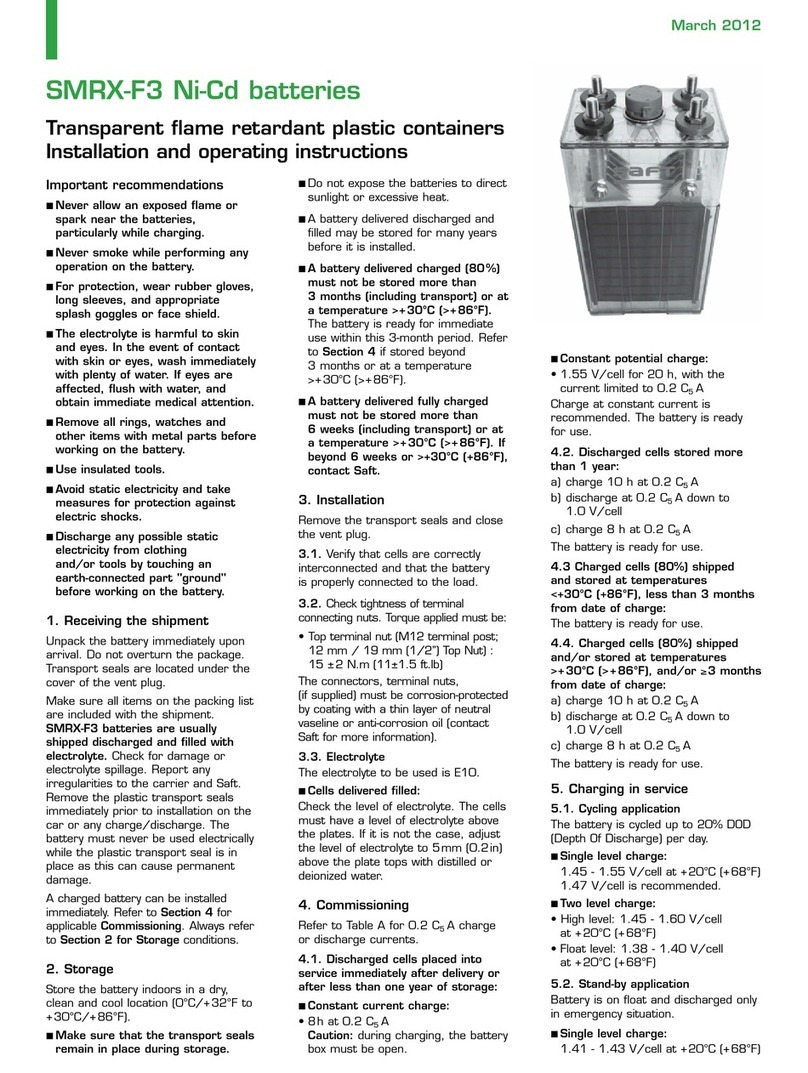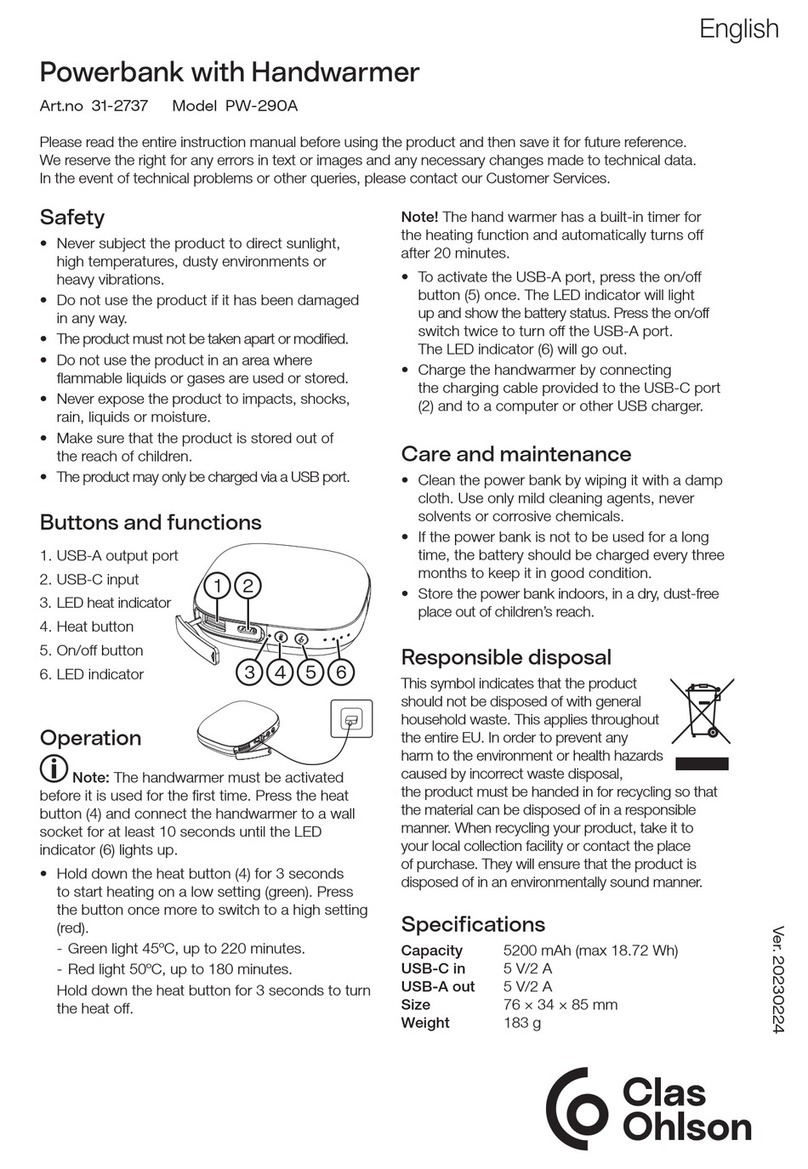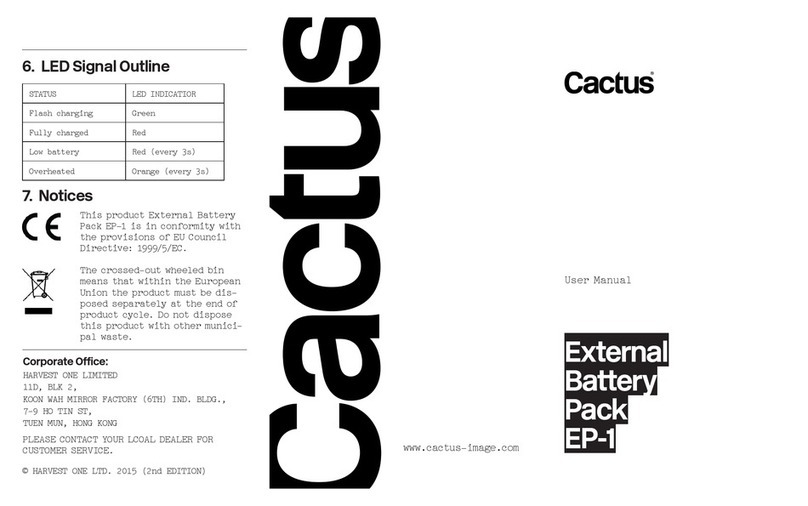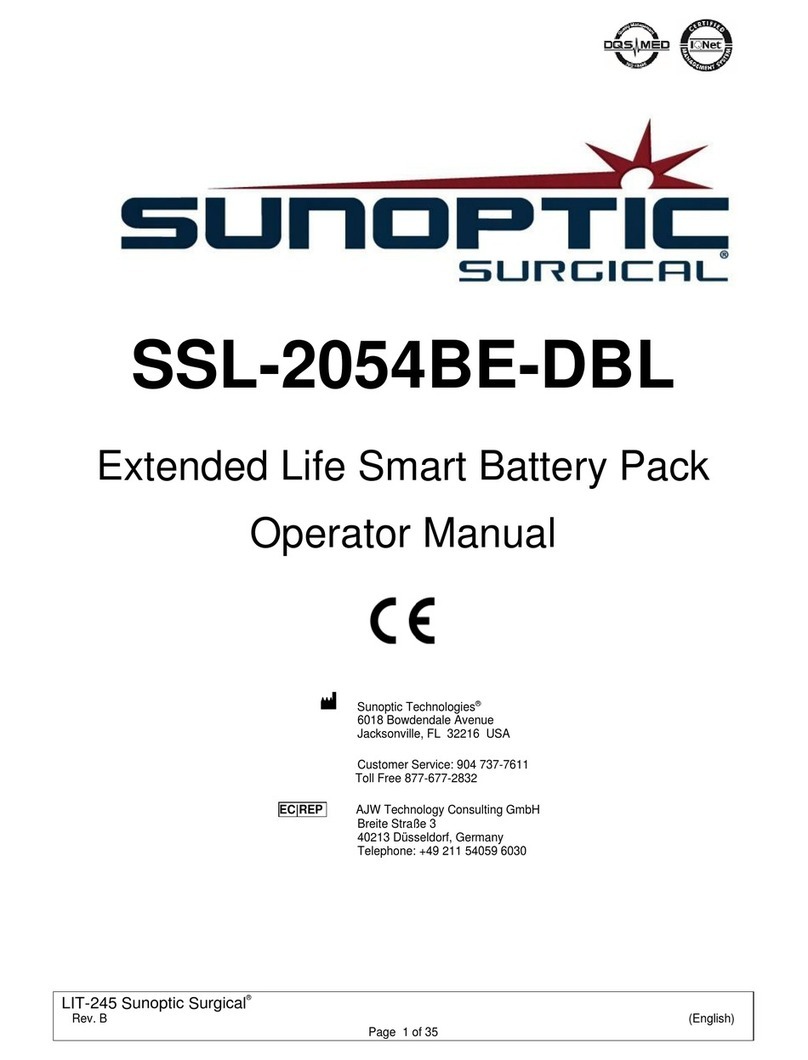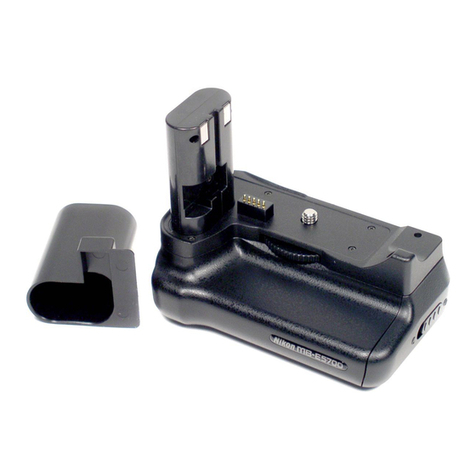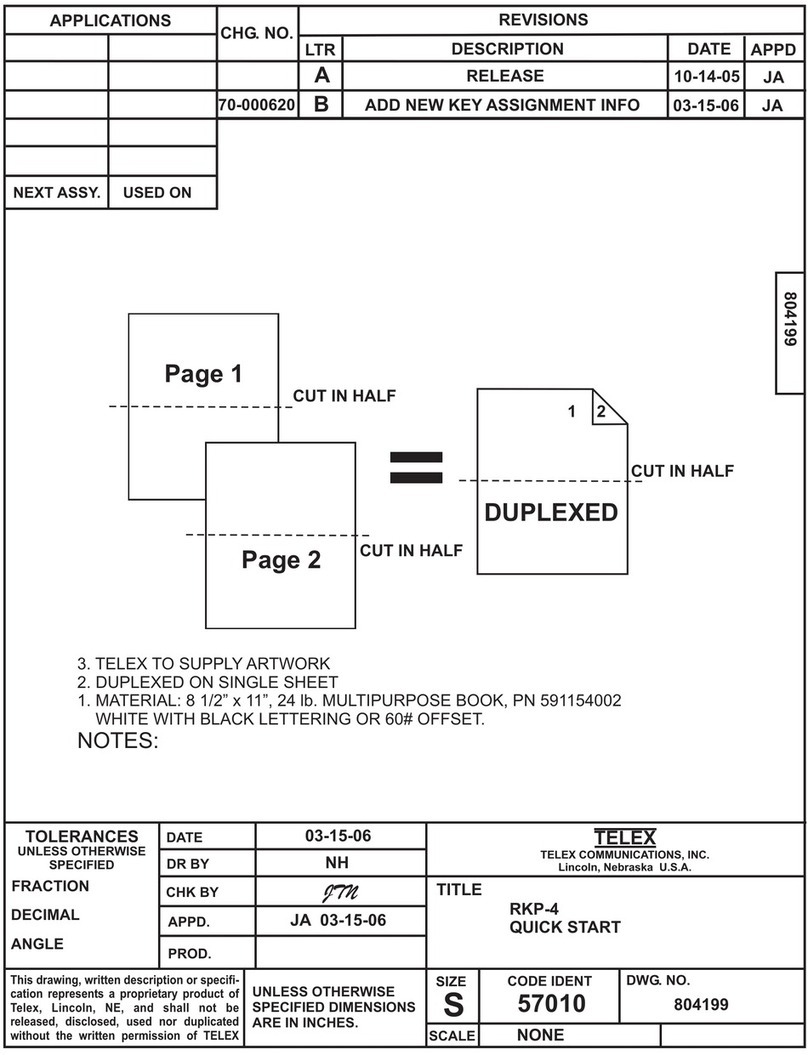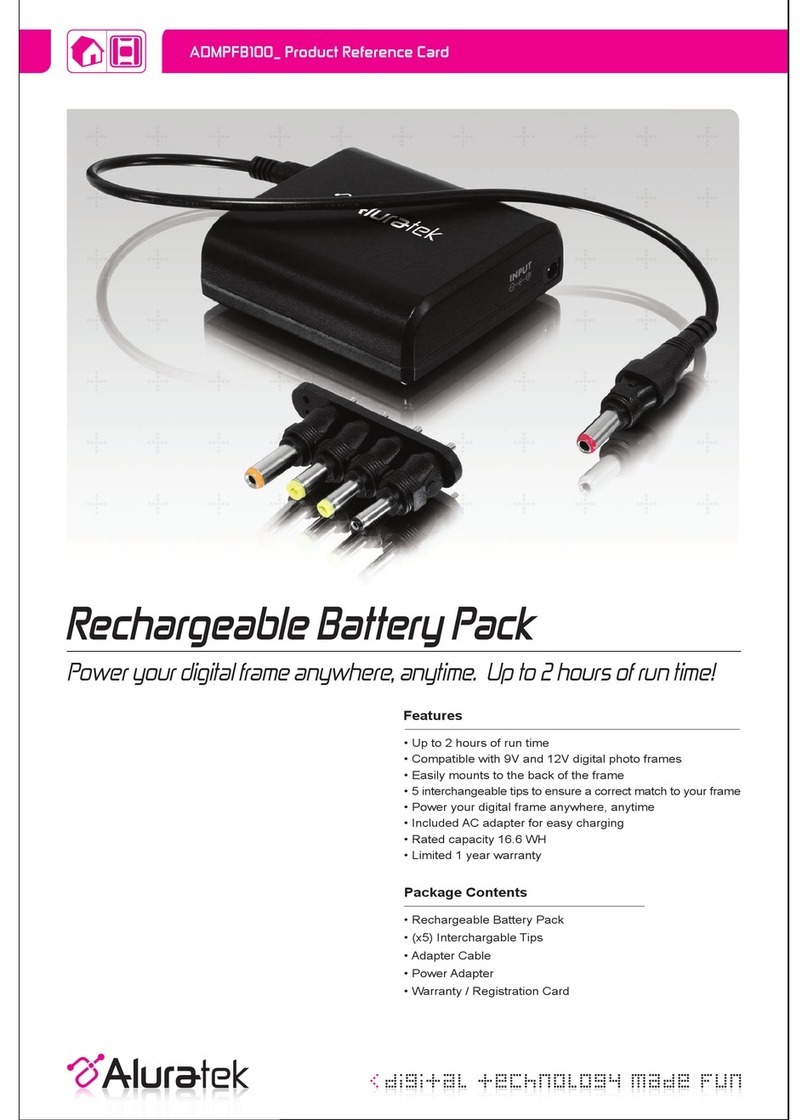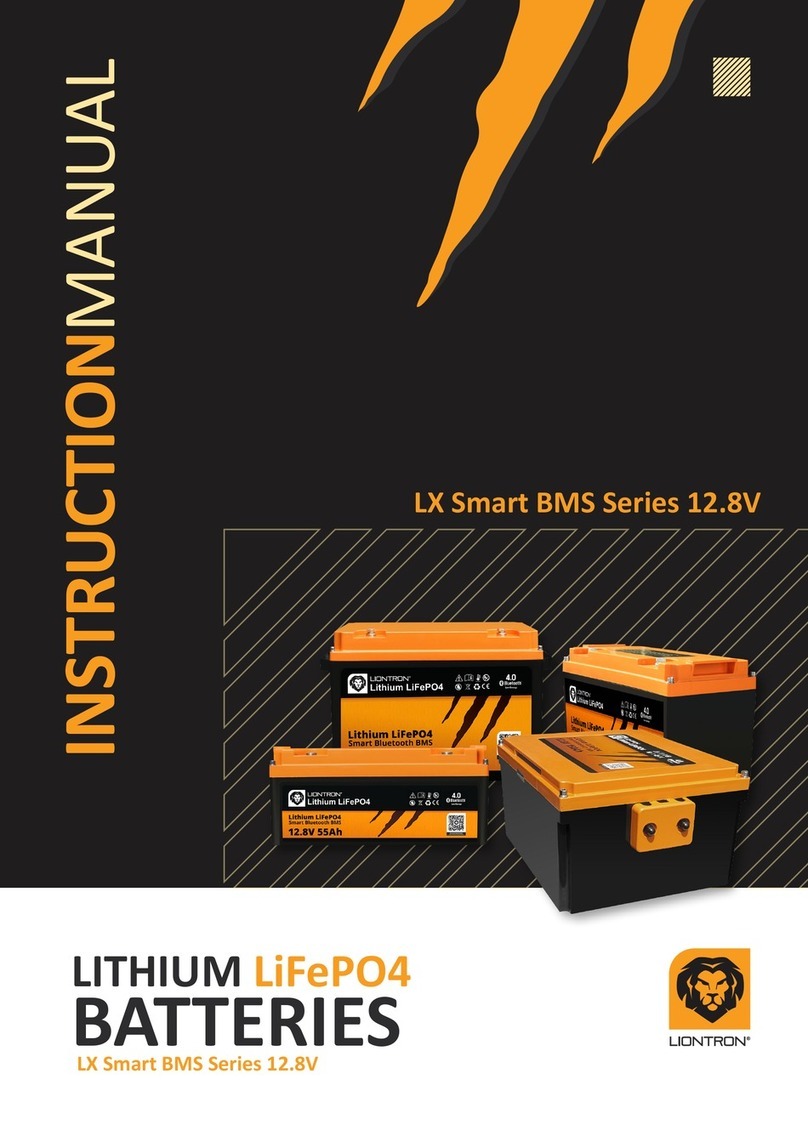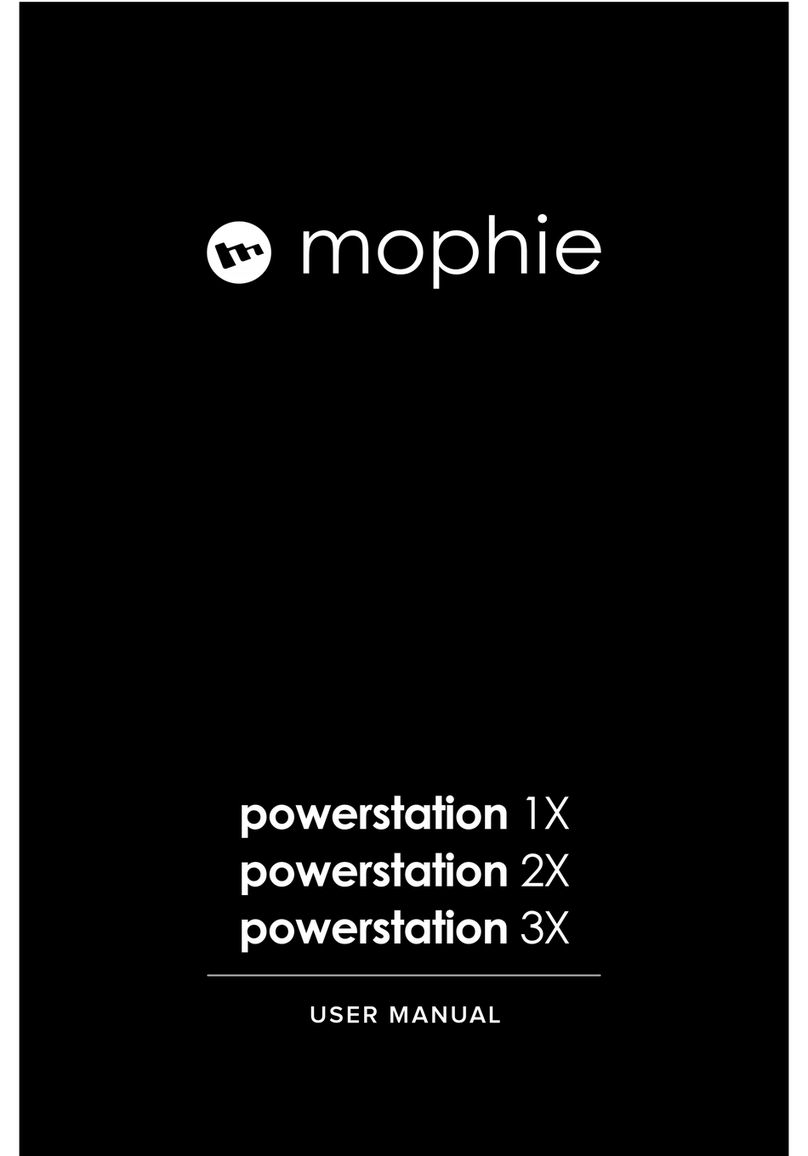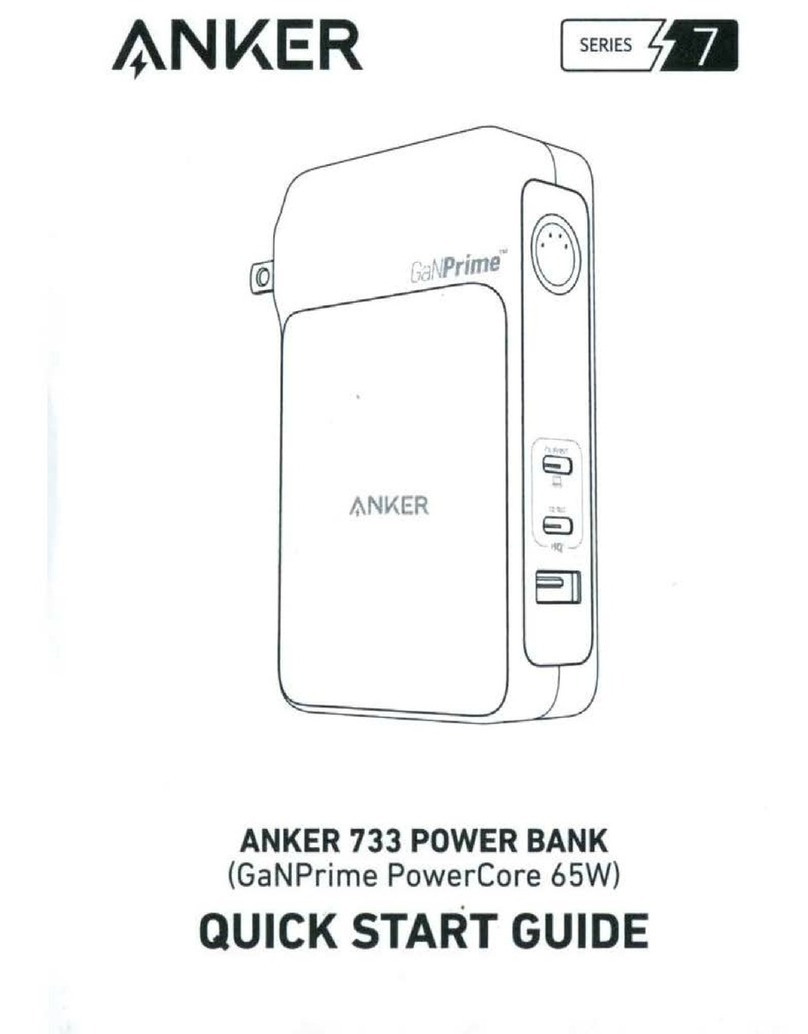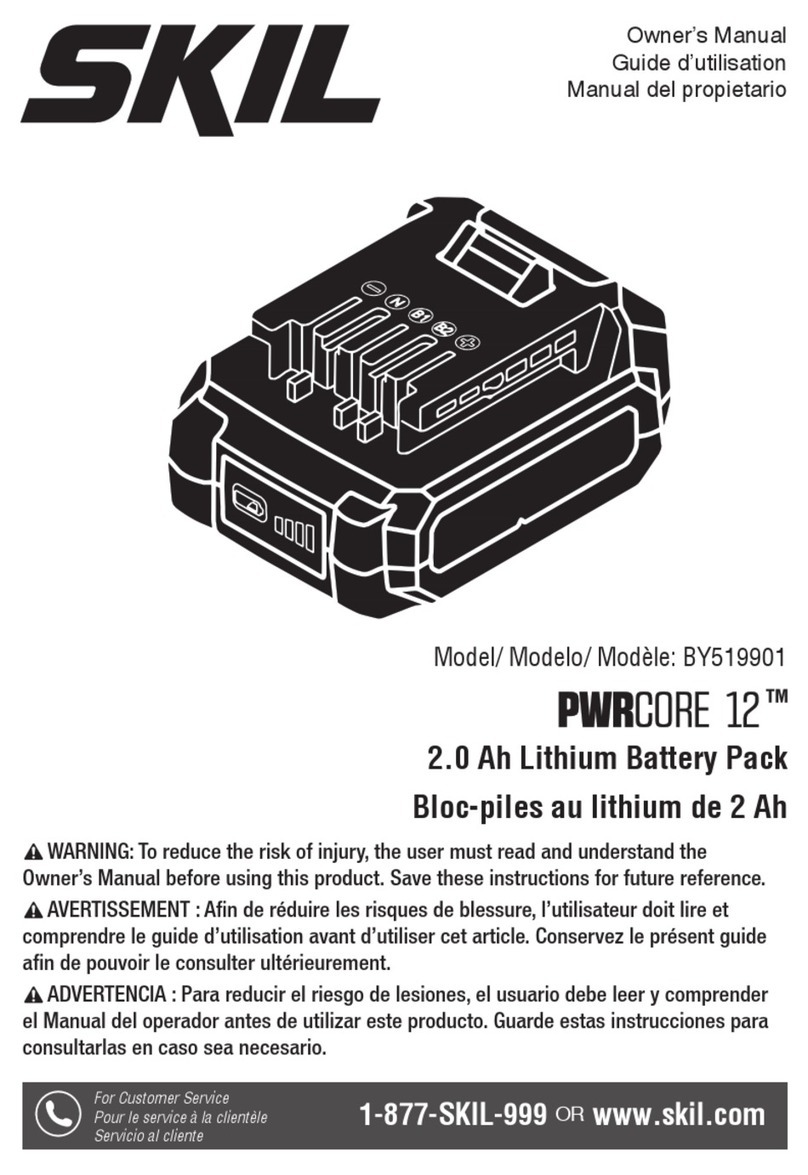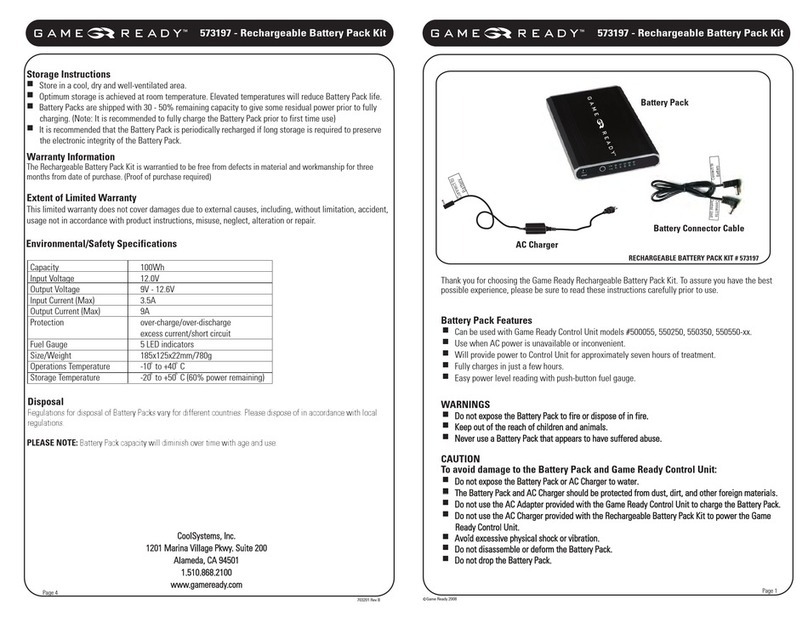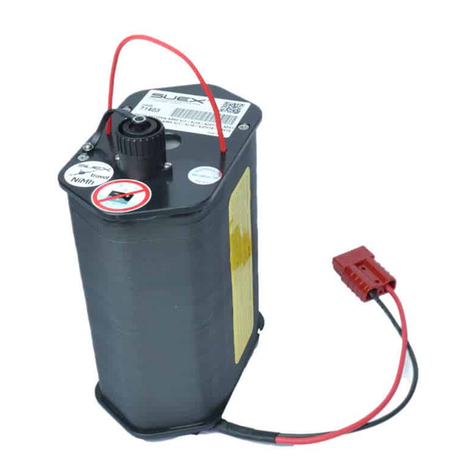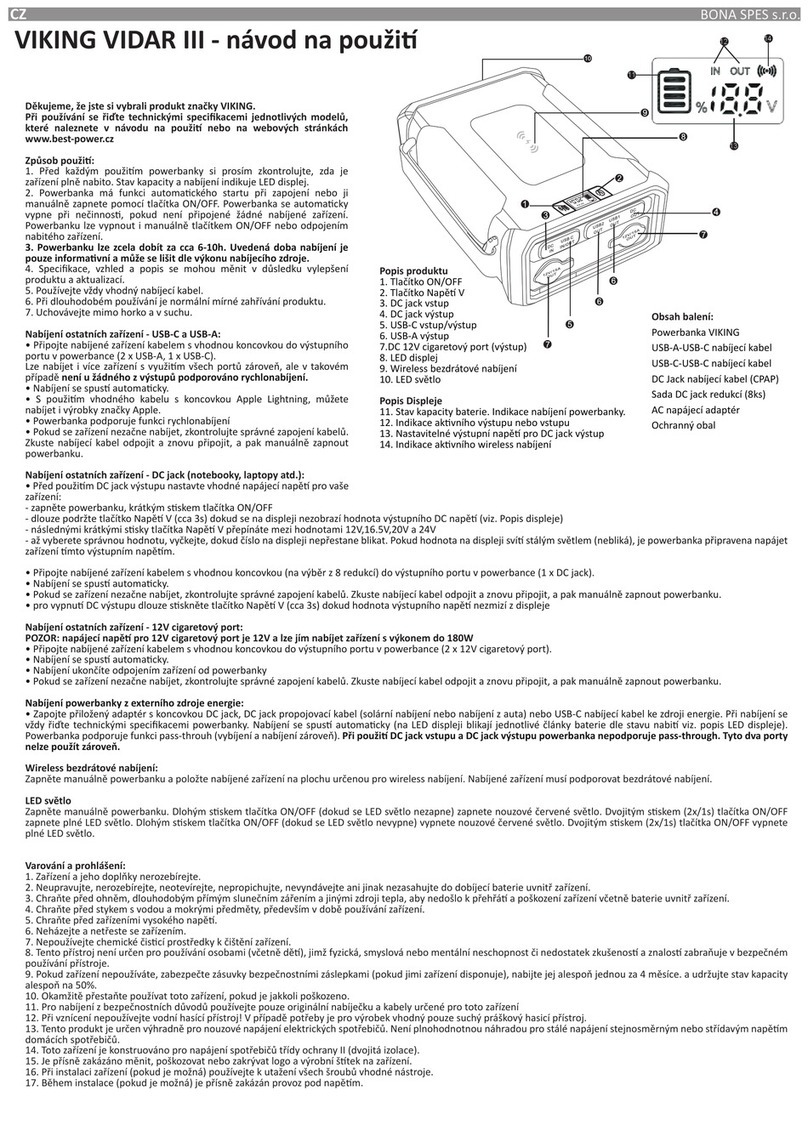MPP Solar LIO II-4810E User manual

User Manual
Version: 1.1
Wall-mounted
Lithium-Iron Phosphate
Battery module

Table of Contents
1. Overview................................................................................................................................................1
2. Introduction ...........................................................................................................................................2
2.1 Product Overlook.............................................................................................................................2
2.2 Menu Operation Instruction............................................................................................................5
2-3. The Working Principle.....................................................................................................................6
2-4. Product Features ............................................................................................................................7
2-5. Battery Active Equalization.............................................................................................................8
3. Installation Guide...................................................................................................................................9
3-1. Installation Precaution Notes .........................................................................................................9
3-2. Installation Procedure ..................................................................................................................11
3-3. Installation Method......................................................................................................................13
4. Maintenance........................................................................................................................................14
4-1. Electrical Maintenance.................................................................................................................14
4-2. Battery Maintenance....................................................................................................................14
4-3. Trouble Shooting Steps.................................................................................................................15
5. Specification.........................................................................................................................................16
5-1. Technical Specification..................................................................................................................16
5-2. Main performance index of the battery .......................................................................................17
5-3. Battery Characteristics..................................................................................................................19
6. Environment Protection.......................................................................................................................20
6-1. Environmental Label.....................................................................................................................20
6-2. Recycle..........................................................................................................................................20
7. APPENDIX.............................................................................................................................................21
7-1. Connection Cable..........................................................................................................................21

1
1. Overview
Thank you for purchasing Lithium battery module. This manual describes the installation and product
parameter settings etc. Please read this manual before you install the battery. Follow the instruction
carefully during the installation process and keep this manual in safety for further information.
Readers
This document provides technical details regarding the tools and infrastructure usedby the following
users:
Sales engineer
Technical support engineer
Installation engineer
Application engineer
Maintenance engineer
Conventions and used symbols
The following symbols may appear in this article, and they are represented as follows:
Symbol
Indication
Dangerous
Used as warning in an emergency, if not avoided, it will result indeath or
serious personal injury
Warning
Used as a warning of a middle or low potential hazards, if notavoided, it
may cause minor or normal injury.
CAUTION
Used as a warning of potential dangers, if ignore this information,it may
result in equipment broken, data lost, equipment performance decrease and
other unpredictable result.
INTRO
Represents the supplement information of main text to emphasizeor
replenish

2
2. Introduction
LIO II-4810E lithium iron phosphate battery is one of new energy storage products. It can be used to support
reliable power for various types of equipment and systems. LIO II-4810E is especially suitable for application scene
of high power, limited installation space, restricted load-bearing and long cycle life.
LIO II-4810E has built-in BMS battery management system, which can manage and monitorcells information
including voltage, current and temperature. What’s more, BMS can balance cells charging and discharging to extend
cycle life. Multiple batteries can connected in parallel to expand capacity and power in parallel for larger capacity
andlonger power supporting duration requirements.
Certification: UL 1642, UN38.3.
2.1 Product Overlook
1. Power on/off button
2. LCD display
3. Operation buttons
Terminal view
4. Battery connectors (including 2 positive poles and 2 negative poles): Using 4-pin terminals, from left to right is
defined as battery+, battery+, battery-, battery-, which is connected with the power transmission line for
charging and discharging.
5. On/Off indicator
6. RUN LED: During charging, the "RUN" light will be flashing.
7. ALM LED: When the battery is at fault, "ALM" LED is lighting red.
8. SOC LEDs: Four LEDs indicating battery capacity.

3
Capacity
●
●
●
●
75%-100%
¤
¤
¤
¤
50%-75%
¤
¤
¤
○
25%-50%
¤
¤
○
○
25%-50%
¤
○
○
○
INTRO:
¤
indicating LED is on.
○
indicating LED is off.
RUN, ALM and SOC LEDs will display battery status as below table.
Battery
status
Normal/Alarm/
Protection
RUM
ALM
Capacity LED
Description
Shutdown
Dormancy
Off
Off
Off
Off
Off
Off
All off
Standby
Normal
Flash 1
Off
According to the battery indicator
Standby
Alarm
Flash 1
Flash 3
The module of low
pressure
Charging
Normal
Light
Off
According to the battery indicator
(Maximum power indicator LED flash 2)
Overcharge alarm.
ALM does not
blink
Alarm
Light
Flash 3
Overcharge
protection
light
Off
Light
Light
Light
Light
Stop discharging.
ALM lighting.
Over temperature
over current, and
invalidation
protection
Off
Light
Off
Off
Off
Off
Stop charging.
ALM lighting.
Discharging
Normal
Flash 3
Off
Based on capacity
Alarm
Flash 3
Flash 3
Under voltage
protection
Off
Off
Off
Off
Off
Off
Stop discharging.
ALM lighting.
Temperature
overcurrent short
circuit reverse
connection failure
protection
Off
Light
Off
Off
Off
Off
Stop discharging.
ALM lighting.
Failure
Off
Light
Off
Off
Off
Off
Stop charging and
discharging.
ALM lighting
Note: Flash1- light 0.25s/off 3.75 seconds; Flash 2-0.5 slight /0.5s off; Flash 3 -0.5 slight/1.5s off.
9. RS485 & CAN: CAN Communication Terminal:(RJ45port) follow CAN protocol, for output battery information.
RS485
Use 8P8C vertical RJ45 socket
CAN
Use 8P8Cvertical RJ45 socket
RJ45 pin
Definition
RJ45 pin
Definition
9, 16
RS485-B1
1, 3, 6, 7, 8
NC
10, 15
RS485A1
5
CANL
11, 14
GND
4
CANH
12, 13
NC
2
GND

4
10. RS232 port: (RJ11 port) follow RS232 protocol, for manufacturer or professional engineer todebug or service.
RS232
Use 6P6Cvertical R11socket
RJ11 pin
Definition
2
NC
3
Tx
4
RX
5
GND
11. Grounding screw
12. RS485 ports: BMS signal transmission for battery modules and for battery capacity extension in parallel.
13. Dry contact: Dry Contact Terminal: provided 2 ways input and 2 ways output dry contact signal.
way 1 way 2
14. ADD: In parallel, band switch using four dip switch to address set cell system.The explanation of its dial switch
as shown in below table.
Address Code
ADD
PACK
Definition
Explanation
1
2
3
4
OFF
OFF
OFF
OFF
0
Use Alone
ON
OFF
OFF
OFF
1
PACK1
Use as SlavePack1
OFF
ON
OFF
OFF
2
PACK2
Use as SlavePack2
ON
ON
OFF
OFF
3
PACK3
Use as SlavePack3
OFF
OFF
ON
OFF
4
PACK4
Use as SlavePack4
ON
OFF
ON
OFF
5
PACK5
Use as SlavePack5
OFF
ON
ON
OFF
6
PACK6
Use as SlavePack6
ON
ON
ON
OFF
7
PACK7
Use as SlavePack7
OFF
OFF
OFF
ON
8
PACK8
Use as SlavePack8
ON
OFF
OFF
ON
9
PACK9
Use as SlavePack9
OFF
ON
OFF
ON
10
PACK10
Use as SlavePack10
ON
ON
OFF
ON
11
PACK11
Use as SlavePack11
OFF
OFF
ON
ON
12
PACK12
Use as SlavePack12

5
ON
OFF
ON
ON
13
PACK13
Use as SlavePack13
OFF
ON
ON
ON
14
PACK14
Use as SlavePack14
ON
ON
ON
ON
15
PACK15
Use as SlavePack15
15. Reset: Press RESET key for 5 seconds, then start the device, press the RESET key for 5 seconds again, then
shut down the device. When the system is running, should therebe an exception, use this button to reset the
system (press / release) to ensure the stability of the system.
2.2 Menu Operation Instruction
The LCD display interface is user-friendly, as shown in below figure. It provides 320 * 240 dot matrix graphic display.
The LCD is able to display the alarm information inreal time, and provides the historical warning records for the user
to query, and provide a reliable basis for fault diagnosis.
Users can easily browse the battery parameters through the LCD interface, and obtain timely access to information
on the current state of the battery. The interfacedisplays a total of 5 menu keys, the functions described as follows.
The commonly used button function
Main menu
Confirm, enter
Page down
Return, launch

6
Operation Procedure
1. Press once, the LCD display screen light up, then the welcome interface will be shown.
2. Followed by the prompt and then click once to enter the main menu bar.
3. Scroll page up, Enter the Menu screen, when the points to the corresponding bar, press Enter
to confirm.
4. Go back on the menu bar, click button.
2-3. The Working Principle
Lithium battery pack is equipped with charging and discharging management moduleand monitoring module.
Charge and discharge management module protects battery charge and discharge functioning, prevents
overcharging, discharge over-current, the charging process bythe adapter charger to the DC input form, the
discharge process is completed by connecting the load discharge.
The monitoring module has the balance function and power, temperature and SOC.The monitoring module
transmits the real-time information collected in the operationof the product through the Telecom protocol network
to the monitoring platform, andthe user can observe the operation status of the battery in each group through the
display screen.
A single module has a 51.2V 100Ah, with a large capacity, can be used in accordance with user requirements
arbitrary combination as shown in below figure.

7
2-4. Product Features
Integrated lithium battery pack for Wall-Mounted has the followingremarkable characteristics:
The whole module is non-toxic, non-polluting and environmentally friendly;
The system can automatically manage charge and discharge state and balancecurrent and voltage of
each cell;
Flexible configuration, multiple battery modules can be in parallel for expandingcapacity and power
Adopted self-cooling mode rapidly reduced system entire noise;
The module has less self-discharge, up to 6 months without charging on shelf ;no memory effect,
excellent performance of shallow charge and discharge;
Working temperature range is from -20℃ to 60℃, (Charging 0~60℃; discharging -20~60℃)
with excellent discharge performance and cycle life;
Small size and light weight, standard of 19-inch embedded designed module iscomfortable for installation and
maintenance;
INTRO:
1. Telemetry: voltage, current, temperature, SOC, SOH (optional), etc.
2. Tel-signalling state of charge and discharge, overcharge / over-current, under voltage over-current alarm /
alarm, environment / battery /PCBA/ battery temperature alarm, low environmental temperature alarm, battery
capacity is too low, the battery temperature /voltage / current sensor failure alarm, batteryfailure alarm (just
not cut off the monomer pressure high limit alarm) (optional),battery failure alarm (optional).
3. Remote control: charge / discharge (optional), alarm sound off, intelligentintermittent charging mode, current
limiting charging mode.
4. Optional: Battery charge / discharge management parameters and the outputparameters of the switching
power supply system.

8
2-5. Battery Active Equalization
Because the battery capacity, internal resistance, voltage and other parameter values are not completely consistent,
this difference causes the battery with the smallest capacity to be easily overcharged and discharged during
charging, and the smallest battery capacity becomes smaller after damage, entering a vicious cycle. The
performance of single battery directly affects the charge and discharge characteristics of the whole battery system
and the reduction of battery capacity. BMS without balance function is just a data collector, which is hardly a
management system. BMS active equalization function can realize the maximum continuous 1A equalization current,
transferring the high-energy single battery to the low-energy single battery, or using the whole group of energy to
supplement the lowest single battery. During the implementation process, the energy is redistributed through the
energy storage link, so as to ensure the battery consistency to the greatest extent, improve the battery lifecycle and
delay the battery aging.

9
3. Installation Guide
3-1. Installation Precaution Notes
Comply with local laws and regulations
When operating the equipment, make certain to comply with local laws andregulations.
Personnel requirements
Technicians who are responsible for installation and maintenance are required to undertake strict training at
first. Master the correct methods for operation and safety, only then the installation, operation and
maintenance can be carried out.
In order to maximize the efficiency of the equipment, to obtain best possible operating results, and ensure
maximum lifespan, please pay careful attention to thecorrect installation and usage requirements.
Personal safety
Insulated tools and gloves should be used and worn at all times –During the installation process, watches,
bracelets, rings and other metal products shouldbe removed.
Avoid any fall or collision during the installation process.
Do not remove the battery components. The maintenance of the battery shouldbe carried out by a professional
engineer.
Should be operated and supervised by engineer who have experience and cantake preventive measures for
potential hazards of battery.
Field and environment
Site requirements
1. Cleanliness
Lithium battery packs cannot be placed in or near garbage disposals, or accidentally dropped or placed in smaller
disposal units, as their interaction with metals is likely tocause short circuits and endanger the system and personal
safety.
2. Fire protection
The room is prohibited to store flammable, explosive and other dangerous goods,and it should be equipped with
effective fire equipment (such as CO2 fire extinguishers).
3. Ventilation and heat dissipation
In order to facilitate the operation and maintenance of equipment for the heat, the equipment should be left around
(50~30) cm around at least, left about 50cm for theupper space. The space should be equipped with exhaust fan,
to maintain good indoor ventilation.
4. Installation requirements
Installation should be carried out as shown in figure 3-1 in order to avoid possiblerisks.
Put the lithium battery on the ground (to avoid tilt, uneven ground).
Avoid placing in the sunlight, rain or wet surfaces.

10
5. Environmental requirements
Ambient temperature: ( -10~+40) ℃.
Relative humidity level: 0%RH~95%RH, no condensation.
Cooling method: air cooler.
Height above sea level: match to the standard requirement of GB3859.2-93.
Verticality: no vibration and the vertical inclination does not exceed 5º.
Pollution level: Levelⅱ
Recommended operating temperature (20~25) ℃, humidity level control within 50%.
CAUTION
Do not install in the working environment with metal conduction typedust. Do not put
anything containing corrosive gases.
Do not put anything in the dust concentrated areas.
Do not place any items on the top of lithium-ion battery pack. People could notsit on
the battery.
Power Check
Before installation, please confirm that the load capability of inlet wire meets the requirements of the new
equipment. Check to see if the power supply corresponds tothe equipment nameplate of the voltage and frequency
and if the current capacity has decreased due to the aging of the wire.
If in doubt, please check with your local power supply Consultation Department.
Ground wire
Earthing terminal is ready; zero voltage required in the room cannot exceed 5V.DC output voltage and load capacity
Lithium-ion battery pack of rated DC output 51.2V.
DC output power

11
CAUTION
When installing the lithium-ion battery pack, the user should check the lithium-ion battery
pack in advance to make sure that the contacts and connectors are safely in place to avoid
an open circuit or short circuit fault.
During installation, do not connect the lithium batteries polarity in reverseor in any way
incorrectly, to avoid causing a short circuit.
Please do not connect the terminals with no security or insulation protection,so as to avoid
the risk of electric shock.
3-2. Installation Procedure
3-2-1. Unpacking and inspection
Lithium batteries and accessories use packaging of cardboard boxes or wooden boxes. When unpacking, be careful
when dismantling. Inspect the device and accessories according to the package list, to ensure it’s complete and
make certainnothing was damaged during shipping.
Before clearing the packaging, make sure that all parts are included. If equipmentor accessories are damaged in
transit, or incomplete or incompatible, the equipment, accessories and order contracts should be recorded andlocal
dealer should be contacted immediately.
The site needs to be tidied and inspected once again to make sure the audit documents are in order for the audit.
Before inspection, the site should be clean.
3-2-2. Installation Tools
Potential commonly used tools as shown in below tables the field technician willincrease or decrease the amount
according to the construction.
Table 1: General purpose tools
The appearance of the tools, parameters, and names
Adjustable
wrenches
Phillips screwdriver
Slotted screwdriver
Socket wrench
Torque wrench
Open-end
wrenches
Double offset ring
spanner
Diagonal cutting
pliers
Wire cutters
Needlenosed pliers
Marking pen
Working gloves

12
Ladder (2m)
Flashlight
Tape measure
Impact drill
Table 2: Tools for delivery and unpacking
The appearance of the tools, parameters, and names
Manual forklifts
Electric forklift
Sling
(weight≥400kg)
Leverage
(weight≥400kg)
Table 3: Electrical installation tools
The appearance of the tools, parameters, and names
Insulated gloves
Power cable
crimping plier
Wire stripping pliers
Electrical tape
Table 4: Measuring Tools
The appearance of the tools, parameters, and names
Clamp the flow table

13
3-3. Installation Method
1. Use expansion screws to fix the accessory bracket shown below on the wall.
2. Hang the battery box on the stand.
3. Use M6 screws to secure the case from both sides.

14
4. Maintenance
In order to ensure the lithium-ion battery pack achieves the longest life cycle, the maintenance technician should
carry out regular inspections and maintenance care. The maintenance records should be complete and routine, so
that subsequent verification of management parameters of the battery pack can be tracked.
4-1. Electrical Maintenance
Maintenance of the electrical parts may refer to table.
Items
The checking Points
Methods
Repair conditions
Repair solution
Electrical
Check if theOutput
of the voltage is
normal.
Multimeter
Battery voltage out of
range set
See the following
troubleshooting
section
Fault
inspection
Check if lights are
normal
Visual
inspection
Alarm
Cable
Insulation,
Terminal
Visual
inspection
Insulation cracks,
aging
Replace the cable.
Exfoliated,
corrosion of the
terminals
Replace the terminal
block
4-2. Battery Maintenance
Frequency
Items
Solutions
Monthly
Operating
environment
Stay away from heat source and avoid direct sunlight.
Visual
inspection
If there is any breakage, leakage or deformation,Isolate the
problematic battery pack, take a photograph and replace the
battery.
Quarterly
Visual
inspection
Use cotton cloth to clean the appearance. Be carefulduring cleaning
because the voltage is high.
Connection
status
Check each terminal, check the bolt, if it’s loose,and tighten
it again.
Check the reason if the cabletemperatureexceeds 40℃.
Every 6
months
Measure and
recordthe
voltage
At the final stage of charging, record the voltage; make sure
the positive and negative voltage of the battery are the same.
Otherwise, should check and repair the corresponding
connection cable.
Collect the discharging data at least once everysix months
for the first year.
In the second year, capacity is determined by every three
months. Through the RS232interfaceto view history, which
shows frequent overchargeof a battery in the alarm message,
indicating thatthe batteries have reached the charging and
discharging protection point. This may result in time for
preparing electricity is not enough and suggest changing the
battery immediately.

15
4-3. Trouble Shooting Steps
①Problem determination based on:
1. Whether the battery can turn on or not;
2. If battery is turned on, check the red light is off, flashing or lighting;
3. If the red light is off, check whether the battery can charge/discharge or not.
Preliminary determination steps
1. Battery cannot turn on, switch on the lights are all no lighting or flashing.
If the battery external switch is ON, the RUN light is flashing, and the external power supply voltage is 51.2V or
more, the battery still unable to turn on, pleasecontact local dealer or installer.
2. The battery can be turned on, but red light is lighting, and cannot charge or discharge. If the red light is
lighting, that means system is abnormal, pleasecheck values as following:
a. Temperature: Above 50℃or under -10℃, the battery could not work.
Solution: to move battery to the normal operating temperature range between -10℃and 50℃
b. Current: If current is greater than 100A, battery protection will turn on.
Solution: Check whether current is too large or not, if it is, to change the settingson power supply side.
c. High Voltage: If charging voltage above 54V, battery protection will turn on.
Solution: Check whether voltage is too high or not, if it is, to change the settingson power supply side.
d. Low Voltage: When the battery discharges to 44.5V or less, battery protection will turn on.
Solution: Charge the battery for some time, the red lightturn off
Excluding the four points above, if the faulty is still cannot be located, turn off battery andrepair.
3. The battery cannot be charged or discharged
a. Cannot be charged:
Disconnect the power cables, measure voltage on power side, if the voltage is 53~54V, restart the battery, connect
the power cable and try again, if still not work, turn off battery and contact local dealer or installer.
b. Unable to discharge
Disconnect the power cables and measure voltage on battery side, if it is under44.5V, please charge the battery; if
voltage is above 51.2V and still cannot discharge, turn off battery and contact local dealer or installer.

16
5. Specification
5-1. Technical Specification
The main physical dimensions for a single module is shown below and refer to below specification table for r a
single battery module.
Outline Drawing

17
Specification of one single module
Rated Capacity (5HR)
100 Ah
Nominal Voltage
51.2 V
Discharge ending voltage
43.2V
Charging limited voltage
58.4V
Max. charging current
50A
Max. continue discharge current
100A
Weight
Aprox. 43 kg
Display
With display screen
Protocol
CANBUS
Parallel connection
Parallel connection is up to 15 pcs
(optional)
Dimension (W x D x H) mm
450 x 500 x 140 mm
Design life
More than 15 years
Cycle life
3500 times @ 25°C 0.5C,80% DOD
IP class
IP65
Outer package material
White bake lacquer steel case
(optional)
Operating temperature
Charging: 0 to +60°C, Discharging: -20 to +60°C
Storage: -20 to +60°C
5-2. Main performance index of the battery
The electrical performance is listed below table.
Items for test
Testing methods
Requirements
0.1C
discharge
performance
Standard battery charge, 1h within 1h
with 0.1C discharge current to 43.2V,
Record the discharge time.
Discharge time ≥600min
0.5C
discharge
performance
Standard battery pack, 1h within 0.5C
discharge current to 43.2V, record the
discharge time.
Discharge time≥ 115min
High
temperature
performance
After the battery pack is charged in the
standard (60 ± 2) ℃ high temperature
box for 4 hours and thendischarged to
43.2V at 0.1C, record the discharge
time.
Discharge time≥ 600min

18
Low
temperature
performance
(-10 ℃)
After charging, the battery pack is put in
the low temperature box of(-10 ± 2) ℃
for 6 hours, then discharged to 43.2V at
0.2C at this temperature, record the
discharging time.
Discharge time≥ 180min
Low
temperature
performance
(-20 ℃)
After charging, the battery pack is
allowed to stand for 6 hours at (-20 ± 2)
℃, then discharged to 43.2V at 0.2C at
this temperature. Record discharge time.
Discharge time≥ 120min
Table of contents
